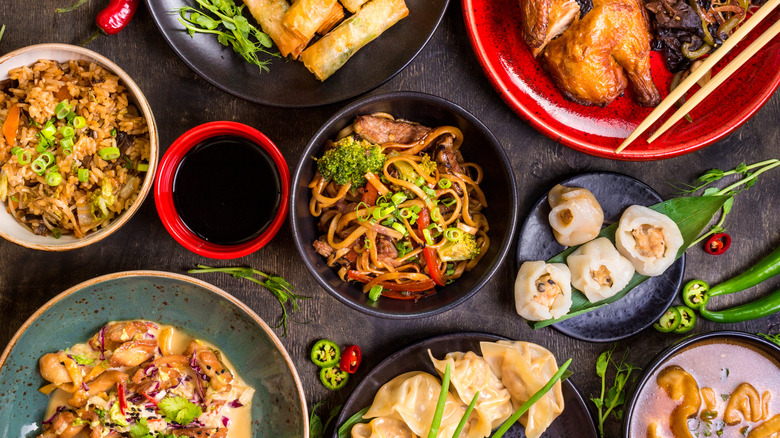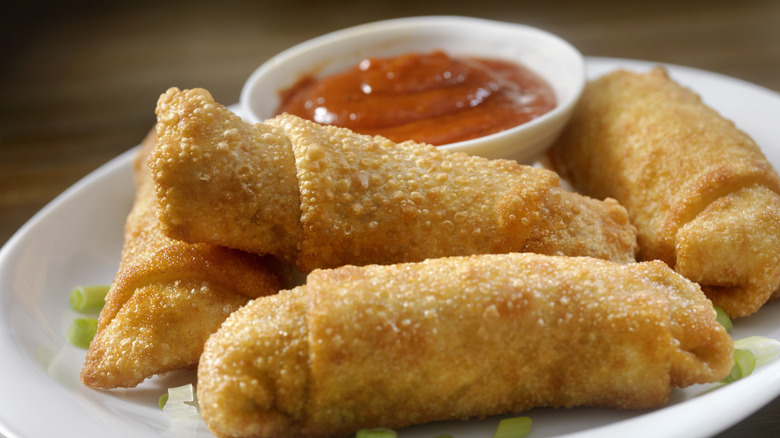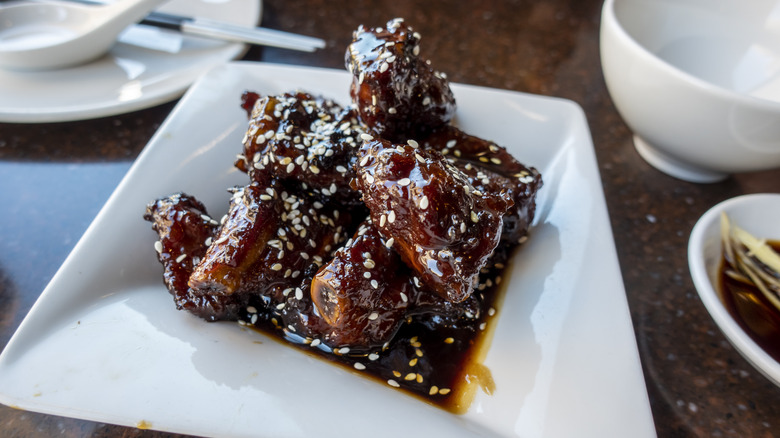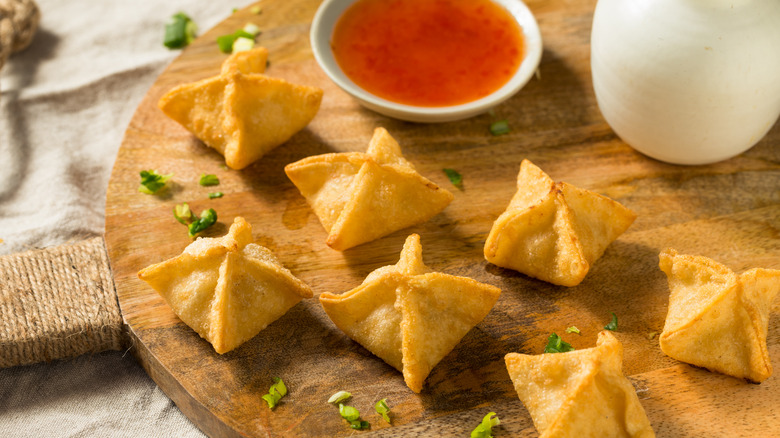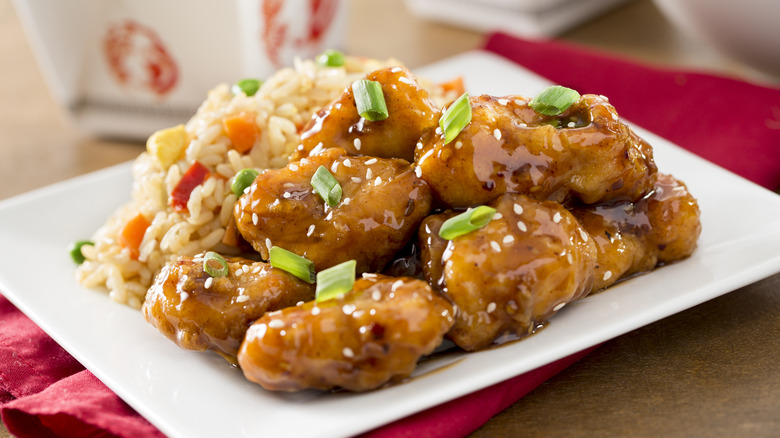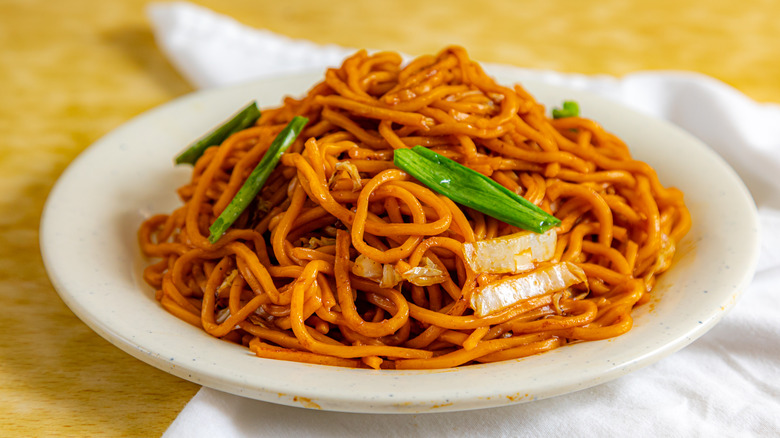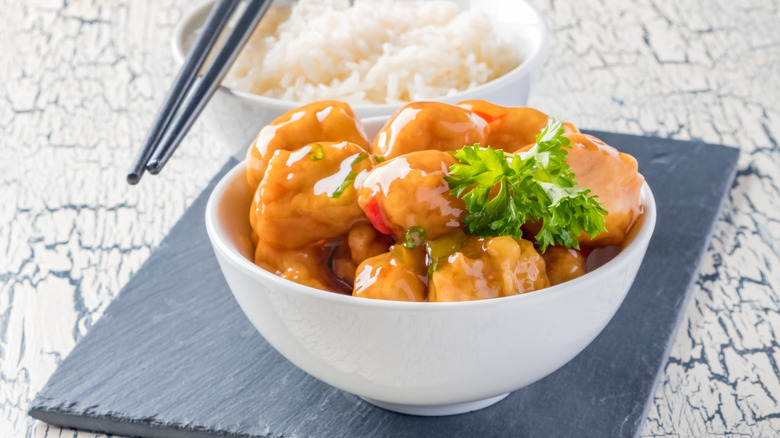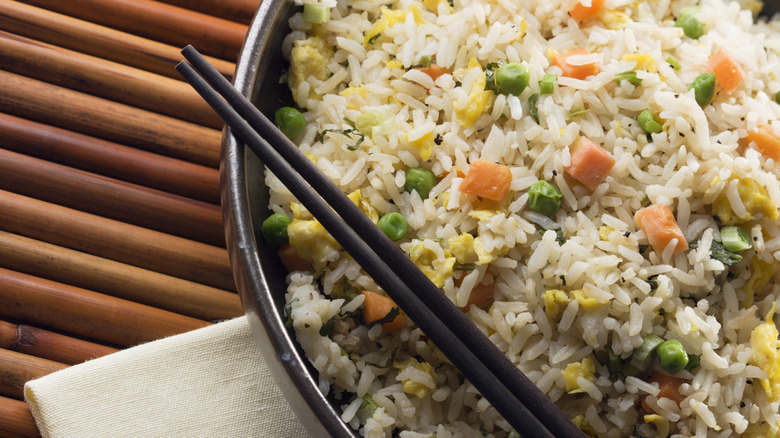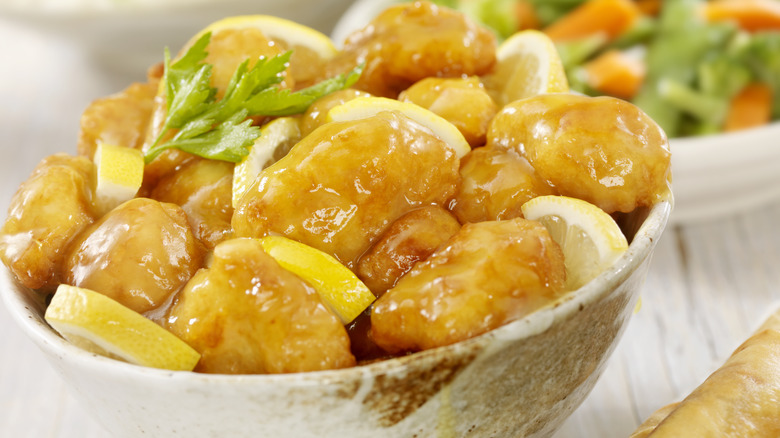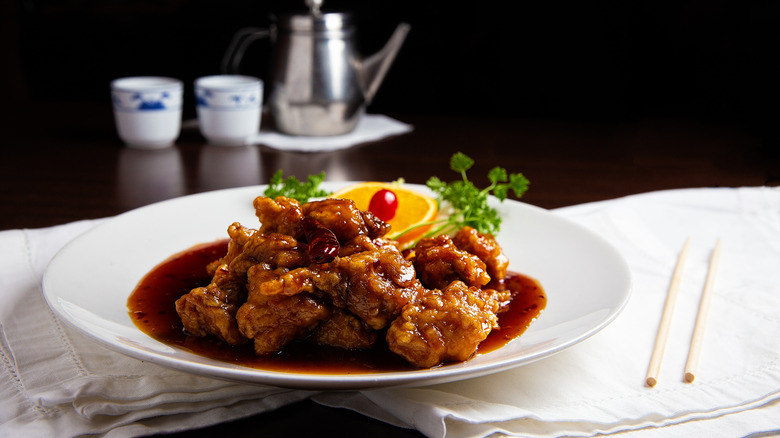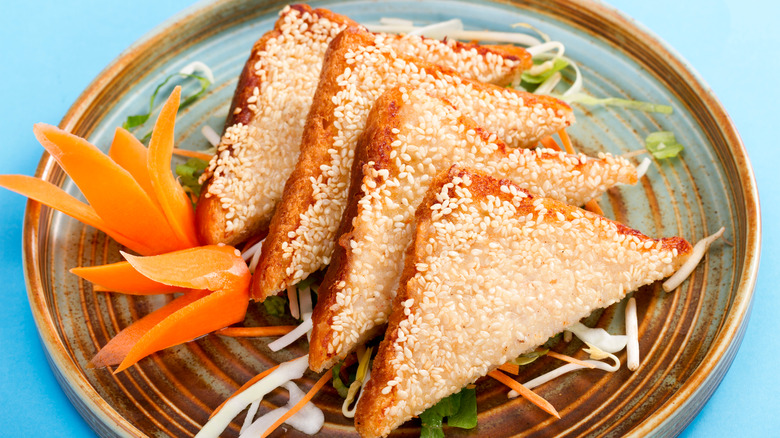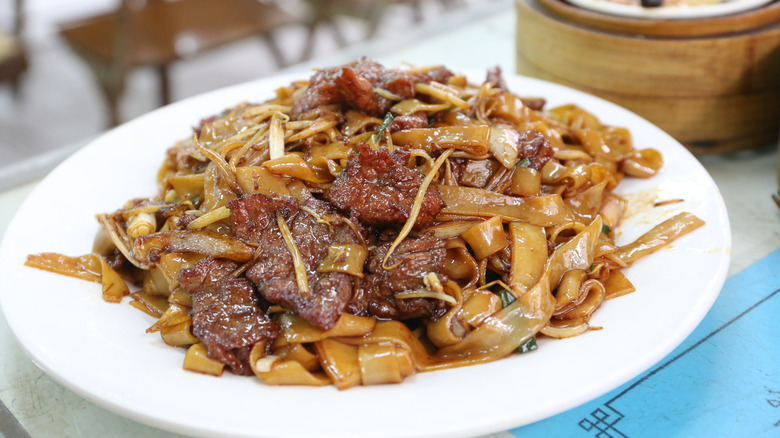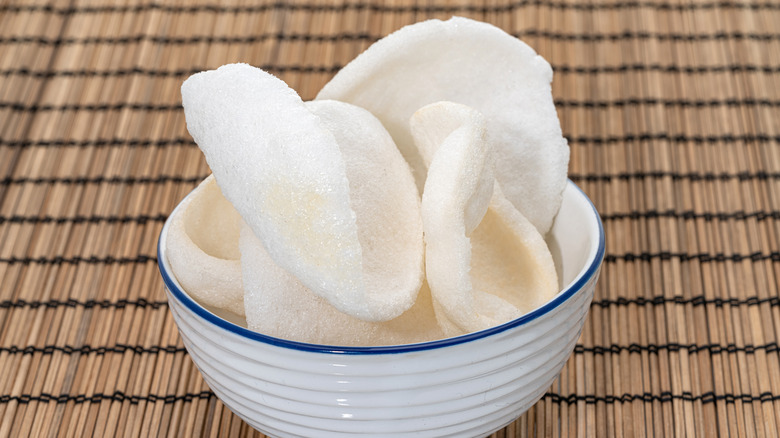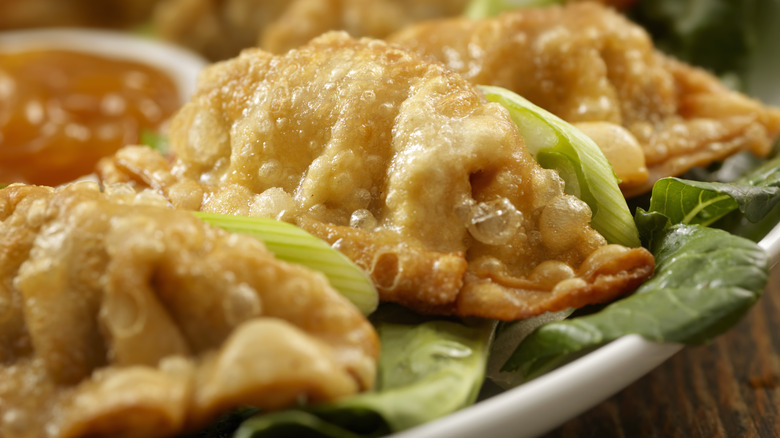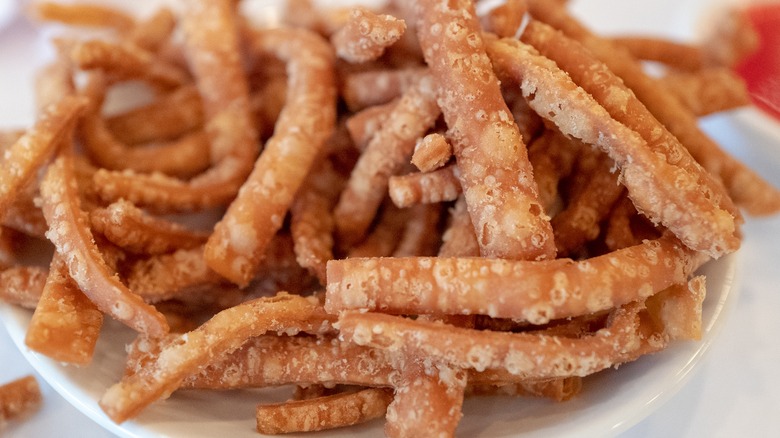14 Of The Unhealthiest Dishes At Your Favorite Chinese Restaurant
Chinese food is inventive, diverse, and delicious, so it's little surprise that it's one of the most popular cuisines both across the world and in the U.S. The popularity of Chinese food in the United States dates back to the end of the 19th century, with postbellum Chinese migrants bringing new recipes and food techniques to cities across the country. From there, more and more people fell in love with the distinctive flavors and textures of Chinese cuisine.
Today, there are more than 24,000 Chinese restaurants across the United States, and most people are familiar with the all-time classics on their menus, like lo mein, fried rice, and General Tso's chicken. But some of these foods may not be the best choice nutritionally. Like all takeout foods, Chinese food, and specifically American-Chinese food, can occasionally be high in sugar, fat, and salt, with certain recipes amping up their quantities for maximum taste. While there are copious items on Chinese restaurants' menus that are ultra-healthy and impart flavor through incredible flavor combinations and fresh ingredients, there are others that are usually pretty unhealthy — and some of the unhealthiest ones might surprise you.
1. Egg rolls
Egg rolls are crispy, deep-fried parcels of vegetables and meat that are small enough to go down in one or two bites, and as such, it's hard to see how they'd pose much of an issue nutritionally. But they can pack a surprisingly high amount of calories and fat into each piece. One egg roll, weighing in at approximately 89 grams, contains around 220 calories. A large proportion of these calories come from fat, with over 10 grams in each serving, including almost two grams of saturated fat. This fat comes from its cooking method, when it soaks up much of the oil that it's being fried in.
Out of context, those numbers don't sound like a lot — until you remember that egg rolls are designed to be an appetizer and not a main course. With that in mind, you could be eating over 10% of your daily caloric intake with just one small piece of food. Additionally, while you may be able to keep to just one egg roll, it's the kind of food item you can consume two or three of without thinking about it before you've even got onto your main course.
2. Barbecue spare ribs
Barbecue spare ribs might seem like a high-protein, low-carb choice, but the cut of meat that's used to make them is almost ludicrously high in fat. In just 3 ounces of pork spare rib, there are 337 calories, almost 26 grams of fat, and 9.5 grams of saturated fat. To put it into perspective, that's almost ½ of your daily value of saturated fat in 85 grams of meat.
And that's all before you think about the glaze that's going to go on top. Part of the appeal of barbecue spare ribs lies in the glossy, thick sauce they're coated in, but this sauce is often high in sugar and sodium and may have additional fat from vegetable or sesame oil. This will raise the overall calorie and carbohydrate count of the dish, and as it's pretty hard to assess precisely how much of each ingredient has gone into the glaze, you may be consuming way more than you think. This is made all the more concerning when you consider that barbecue spare ribs are often eaten as an appetizer, making them a high-calorie, high-fat way to start your meal.
3. Crab rangoon
Crab rangoon is a mash-up of flavors, textures, and influences. Combining crab and cream cheese in a wonton wrapper and then deep-fried until crispy, this appetizer combines a lot of different things in one go. Unfortunately, a few of these elements are very fat-heavy, meaning that just three pieces of crab rangoon could contain over 21 grams of fat and just shy of 7 grams of saturated fat.
Crab rangoon can also be very salty. Those same three pieces contain approximately 510 milligrams of sodium, just over ⅓ of your recommended daily value. Although 2,300 milligrams is often cited as the upper limit for sodium intake, it's actually recommended to keep it lower than that, with no more than 1,500 milligrams daily being the ideal amount. This sodium content is all the more notable due to the fact that crab rangoons are appetizers, and your main course may also be laden with salt. If you're not careful, you could consume more than your daily recommended value of sodium in a single meal — and that's before you add additional soy sauce, with a single teaspoon containing 291 milligrams.
4. General Tso's chicken
One of the most popular Chinese dishes out there is also one of the least nutritious. General Tso's chicken, named for the 19th-century general who counted it as one of his favorite foods, may be delicious, but its combination of deep-fried chicken pieces and a sodium and sugar-heavy sauce makes it very unhealthy. "One order contains 1,578 calories, a whopping 88 grams fat, and 62 grams of sugar, which is the equivalent of almost three days' worth based on American Heart Association recommendations," warns "The Protein-Packed Breakfast Club" author Lauren Harris-Pincus in Eat This, Not That.
Additionally, Harris-Pincus points out that unlike other Chinese dishes, which balance out their deep-fried food with fresh vegetables, General Tso's chicken is devoid of those. This means that it's benefitting from none of the fiber, vitamins, and minerals that these vegetables can provide. Rather than order a regular General Tso's chicken, Harris-Pincus recommends that you order steamed chicken and ask for a side of General Tso's sauce so you can control how much you add. Make sure you combine this with a vegetable dish, too, as the fiber will fill you up.
5. Lo mein
In a lot of ways, lo mein can seem like a smart choice. As a combination of protein, vegetables, and carbohydrates, it's a complete meal, meaning you don't have to worry about ordering any sides. The vegetables in lo mein are also a great source of vitamins, minerals, fiber, and antioxidants.
But unfortunately, lo mein is far less healthy than you might think due to the type of noodles often included. Lo mein noodles are made using white flour, a refined grain that your body digests way faster than whole grains like brown rice. Because it's broken down so quickly, the sugars in the white flour can cause your blood sugar to rise dramatically, which not only causes your energy to crash but can also cause inflammation in your blood vessels, according to WebMD. This can raise the risk of cardiovascular conditions and prove detrimental to overall health.
White flour is also pretty nutritionally redundant. As well as having virtually no fiber, it also doesn't contain any vitamins or minerals. Lo mein can also be very high in sodium thanks to the sauces that are used when cooking it, like soy and oyster sauce.
6. Sweet and sour chicken
Sweet and sour chicken may be a takeout favorite, but it won't do you any favors on a nutritional level. This dish is almost unbelievably calorie-dense and can contain an enormous amount of fat and sugar. In one portion of sweet and sour chicken from a restaurant, weighing approximately 706 grams, there are roughly 1,760 calories – the vast majority of most people's daily recommended amount, and for some people, almost the entirety of what they should be eating in a day. To add to this, there are almost 90 grams of fat and a jaw-dropping 169 grams of carbohydrates, of which approximately 81.2 grams are sugar.
This is all, of course, before you even order a side of rice, which will increase the overall calorie and carbohydrate count. The carbs in sweet and sour chicken come from the breaded coating the meat has on it and the large amount of sugar used to make the sauce so sweet. Consuming high levels of sugar can contribute to inflammation throughout the body, particularly in the joints, causing or worsening arthritis, according to WebMD. Excessive sugar consumption can also contribute to dental issues and faster aging of the skin.
7. Fried rice
An order of fried rice is a must for some people at a Chinese restaurant. But it's far from the healthiest thing you can order on the menu. As you might expect from its name, fried rice is cooked using oil, and depending on the restaurant, there can be a good few tablespoons used to sauté the grains. This will raise your overall fat and calorie intake. Fried rice recipes also frequently include salt, soy sauce, or other seasonings that will amp up the sodium content and may contain additional ingredients like eggs that will raise the fat levels.
Importantly, fried rice isn't all bad. If made with eggs, it can also be a good source of protein, and fried rice is also often made using vegetables that provide some fiber and extra nutrients. As such, if you're ordering it as a main dish with a protein like chicken or tofu added, it can make a pretty filling meal and a relatively healthy order. As a side, though, it may provide extra calories, fat, or sodium you may not need. It's a far better idea to order plain boiled or steamed rice, which is made using no fat or seasonings.
8. Lemon chicken
Like a lot of other Chinese restaurant dishes, lemon chicken can often come drenched in a syrupy, sweet-yet-tangy sauce. And while this is delicious, it also makes it very sugary. There are over 55 grams of sugar in a 637-gram serving of lemon chicken and almost 122 grams of carbohydrates in total, without any rice or noodles in sight. There are also 74.9 grams of fat and over 1,500 grams of sodium.
All of this adds up to a count of approximately 1,437 calories in every serving, which may be far more than you need to replenish your body with the energy it needs. When your body doesn't need the additional calories you've supplied it with, it stores them as fat, which can lead to weight gain, according to the MD Anderson Cancer Center. Bear in mind, too, that you can't assume that just because something's full of calories, it'll fill you up quicker. "It takes about 20 minutes for your brain to send a signal to the stomach to let you know that you're full. Overeating occurs when you continue to eat beyond this point of fullness," explains research dietitian Erma Levy. If you're a quick eater, you could eat an entire portion of lemon chicken way before the 20-minute mark and, therefore, leave your body with a surplus of calories.
9. Orange beef
Orange beef is beloved for its zesty, fresh sauce. And because it contains fruit flavors, this can give the false impression that this dish is somehow lighter or healthier than others. The truth, though, is that orange beef is one of the most calorie-dense things you can order at a Chinese restaurant, clocking in at over 1,200 calories in a one-container serving. There are also over 52 grams of fat and almost 93 grams of carbohydrates, supplied by the sugar and orange juice in the sauce and the cornstarch that coats each piece of beef.
What's especially concerning, though, is the sodium in the dish. In every serving, there are nearly 2,000 milligrams of sodium. This comes primarily from the use of soy and oyster sauce in the meat's marinade. Chefs may also add salt on top of that to give the dish more of a powerful punch of flavor — and it's pretty tricky to know exactly how much salt a chef could be adding in. Asking for less salt or soy sauce in your orange beef can help to reduce the sodium in it, or you can always ask for your sauce to be served separately so you don't end up eating more than you want.
10. Shrimp toast
Shrimp toast is undeniably moreish, and each piece can go down in just a few bites. But those bites are positively packed with fat and calories. A small ½ slice of shrimp toast contains just shy of 150 calories, and a large amount of these come from the 9.27 grams of fat present in the appetizer. That equates to around 12% of your recommended daily value of fat in a tiny piece of fried bread.
Even more surprising is the amount of sodium in shrimp toast. There are approximately 447 milligrams of sodium in every slice. Unfortunately, the presence of high levels of sodium in fried foods is common, and sodium and fat can go hand-in-hand in contributing to adverse health outcomes. A high-fat, high-sodium diet can result in significant weight gain and also increase your resistance to insulin. Having insulin resistance can be the first step on a pathway to pre-diabetes and then to diabetes, according to the National Institute of Diabetes and Digestive and Kidney Diseases.
11. Chow fun
As chow fun skips the regular wheat noodles used in lo mein and instead opts for bouncy, chewy, thick rice noodles, it's tempting to assume that this will result in some nutritional difference. But that's far from the case. Chow fun noodles are made from refined rice flour, which goes through a lot of the same processing that refined wheat flour does. This means that it contains little fiber and not a lot of added nutritional bonuses.
Therefore, you shouldn't expect them to be better for you. "The noodles are thicker, but they're going to do the same damage to your belly and blood pressure as the lo mein," says the Center for Science in the Public Interest's senior nutritionist Jayne Hurley to Newsweek. Chow fun also doesn't usually contain a considerable amount of vegetables, and while it does have some fiber from beansprouts and green onions, it's usually far heavier on the noodles. Chow fun could be a good choice for people who are gluten intolerant, however. As rice noodles are gluten-free, they won't have the same triggering effect that wheat noodles do for intolerances or folks with celiac disease.
12. Prawn crackers
In Chinese cuisine, contrast is everything — and not just when it comes to flavor. "Good Chinese food always has smooth and crunchy. There's always that contrast of texture in Chinese food," says "Simply Ming: One-Pot Meals" author Ming Tsai to the Seattle Times. Prawn crackers offer this difference in abundance, with their ultra-crispy consistency balancing the softness of your noodles, rice, and sauce-based mains.
But while they may have a pleasing mouthfeel, there are a lot of empty calories in them. Prawn crackers are made using tapioca flour, a starch that contains a high amount of carbs but not much else, with barely any vitamins and minerals and virtually no fiber. Unfortunately, this means that the prawn crackers they make, which don't have much more added to them, are similarly nutritionally lacking. What they do have added to them, however, is a relatively high amount of sodium for flavor. And as they're cooked by being deep-fried, they also absorb a large amount of fat from the oil. This is, of course, partly what makes them so delicious — but it also results in each bite being pretty unhealthy.
13. Deep fried dumplings
No Chinese restaurant meal is complete without a side of dumplings. But how you order them makes a big difference to how healthy they are. Steamed dumplings packed with lean meat or vegetables can be a nutritious choice, providing important fiber and protein without too much fat. But "you want to avoid ones that have been completely deep fried," warns Dietitians Association of Australia spokesperson Simone Austin on HuffPost. The dumpling wrappers will absorb the oil that they're cooked in, and while this may make them pleasingly crispy, it also makes them greasier.
Dumplings can also be easy to eat, and this may not be the best thing from a health perspective — before you know it, you've eaten four or five, increasing your fat and calorie intake while still waiting for your main course. Dumpling dipping sauces can also be an important consideration. "We don't want a lot of salt in our diet in general, so you've got to be careful about how much salty sauce you're putting on the dumplings," says Austin, who also recommends opting for a low-sodium soy sauce if possible. If you still want your dumplings to be crispy, ordering a pan-fried option can be an excellent middle ground — you'll still get a nice, crunchy surface while not consuming too much fat.
14. Chow mein
Americanized chow mein can be a very different experience from the Chinese version. Whereas Chinese chow mein is made by pan-frying noodles until they're soft, yet crispy, to make a nest of carbs upon which meat and vegetables are spooned, American chow mein brings a lot of oil to the table. In the Americanized recipe, chow mein noodles are deep-fried until they're crunchy throughout and then broken up and scattered on top of a plate of protein, vegetables, and white rice.
This, of course, isn't exactly the healthiest thing in the world. Deep-frying the noodles means that they absorb a tremendous amount of oil, and it makes these refined carbs even unhealthier. Sprinkling them over your meal may add texture, but it also adds a high level of fat and no added nutrition. You're essentially having a double portion of carbs, putting additional strain on your metabolism and your blood sugar, as stated by the Health Research Institute UK. Any salt that you use to season the fried noodles will also raise your sodium intake. It's far better to go for Chinese-style chow mein or a lo mein that's been made using fewer sodium-heavy sauces and just a little fat to fry it in.
